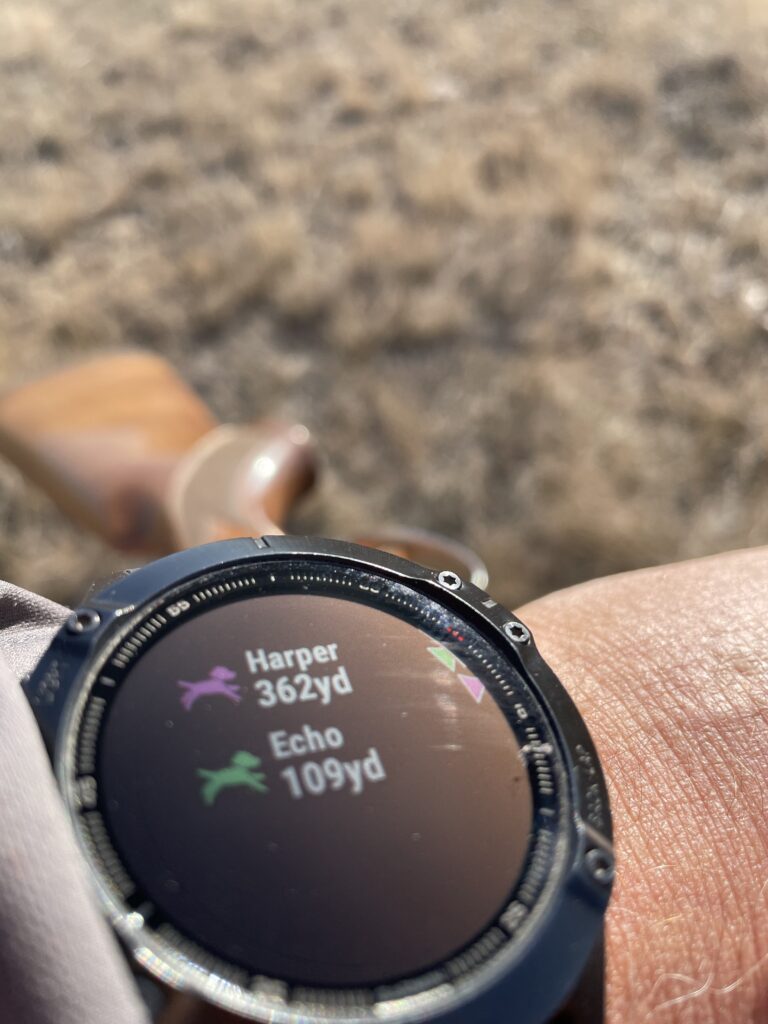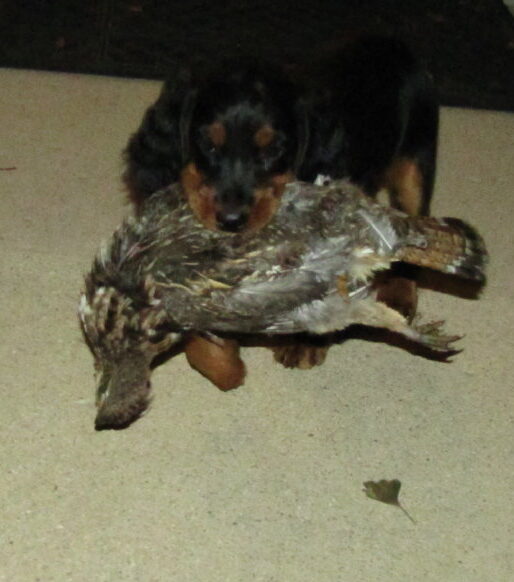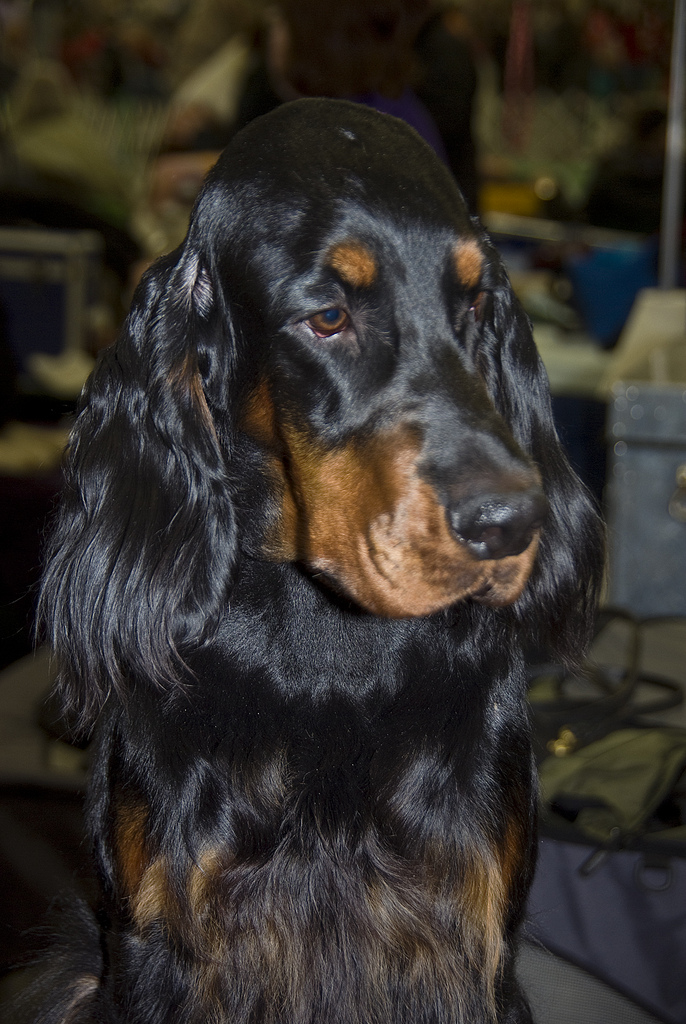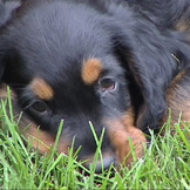We are active members of the Gordon Setter Club of America. For the better part of three decades we have donated our time and resources to support Field Trials, Hunt Tests, Specialty Shows, Supported Entries, Breed Rescue, and field training days in support of Gordon Setters and the running of regional Gordon Setter Club of America business.
We offer this website in part to educate and share our knowledge from over 30 years experience with the breed. Yes, occasionally we offer puppies and this site also helps get the word out. We breed infrequently with quality our primary goal, not quantity. We plan litters carefully with several objectives in mind. These objectives are to preserve and improve hunting drive, stamina, style, trainability, conformation, temperament, and health.
Our broad network means we are able to reach out and select from some of the best dogs available in the breed and not be limited to what is sitting in our kennel. We are not kennel blind and we objectively and carefully evaluate each mating’s potential to improve the breed, our lines, and our goals.
A well bred Gordon Setter –
Beauty, Brains, and Birdsense: “BBB”
We are dedicated to the improvement and preservation of the Gordon Setter breed as represented by the American Kennel Club and the Gordon Setter Club of America. We enjoy Gordon Setters big and small but have a preference for those that fit right in the middle of the breed standard. We especially admire those Gordon Setters that have demonstrate correct conformation to become a bench Champion and also those that excel in the field by earning a Field Trial Championship. These are known as Dual Champion dogs. While we do not compete in the arena of field trials ourselves, we strive for a balance of upland hunting, companionship, and conformation. We admire, support, and will draw genetics from conformationally balanced proven hunting and field trial lines at every possibility.
Bird sense – the first “B“
All game birds are not created equal, neither are bird dogs. In regions with high hunting pressure Ruffed Grouse are difficult to hunt. A pointing dog needs a boatload of experience and bird sense to hunt them well. Ruffed Grouse often sneak off point and flush well ahead of the dog in a thunderous whir from heavy cover. Somewhere someone said it takes 500 grouse contacts to make a grouse dog. Some dogs never get enough experience. Others do but may never figure it out. Dogs that have the right combination of bird sense, training, and experience can reliably hunt and point Ruffed Grouse.
When properly conditioned a Gordon is capable of full day of work. They are not the fastest dogs afield but neither should they plod along. Our Gordons can hunt several days back to back for much of the season. With proper conditioning, nutrition and rest, they improve in stamina and endurance as the season goes on. As expected, cooler weather helps as black dogs don’t tolerate full sun and warm temps well.
A truly useful pointing dog simply must hunt beyond gun range, show a keen interest in seeking birds and express an efficient work-man-like attitude. In heavy cover, a pointing dog that hunts at the range we prefer will be out of sight much of the time. Most importantly though, when properly trained they do not need to be called to check-in, they do it on their own. An electronic beeper collar or better yet a modern GPS tracking system is crucial to track progress in cover. This style of hunting, with the dog out of sight can be uncomfortable to the uninitiated. We like a dog that ranges well, is honest and holds point for great periods of time and doesn’t bust birds. We want to cover large tracts of ground efficiently.
There are fanciers of Gordon Setters suggesting “western” style Gordon Setters are born different than “eastern” Gordon Setters. No doubt genetics play a role in the natural range a dog works but so does exposure, training and opportunity. On grasslands, a dog that works 100 – 400 yards is in my view a comfortable handling range for the foot hunter, others may want to push that out a bit more. My “eastern” dogs open up on the grasslands quite nicely. The east/west debate is childish, ego driven, and superficially divides people and dogs. Don’t fall for it, and do your own homework. If western style grassland hunting is important to you, expose your dog to that environment at an early age. A six year old Gordon that’s never set foot on the grasslands will not develop greater range as readily as a younger dog can, no matter what side of the river it was born. However, a “western style” or open plains dog that’s never set foot in the heavy grouse woods of the midwest may give the owner anxiety when it blasts out 400 yards and can’t find the handler to check in. A local nickname for those dogs is “wolf bait”.
A word about bells. At one time there was really no choice, and there are some traditionalists today that enjoy the sound of a bell ringing out. Today some handlers recognize bell use impairs a dog’s hearing, and long term use may cause permanent damage. Dogs wearing bells in heavy cover stop moving regularly to silence the bell so they can hear and locate the handler or other dogs they are working with, interrupting field work. Some feel the sudden silence can cause grouse to freeze or hold point. Grouse do what grouse do, and if you hunt enough you’ll find grouse holding fine for belled dogs, and there are videos to document this occurrence. What then do they think about the birds that flushed ahead of a belled dog, or birds that flushed ahead and were not heard over the bell? A bell’s limited range is useful for close work in heavy cover. Bells are less effective in high wind or open field cover where there is little cover to reflect sound back to the handler. Some dogs naturally and effectively work well beyond bell range. Lastly, a lifetime of shotgunning takes a toll on hearing acuity, lower frequency bells are helpful here. If you like using a bell, try wearing one on your own boot for a few hours before deciding to put it on your best friend. There are better ways. . .
Today, we prefer quiet dog work managed through GPS tracking. These devices provide long distance tracking far beyond hearing range making it virtually impossible to lose a dog. In habitat where wolves are present a dog lost overnight is to be avoided at all costs. Some wolves are known to be drawn to the sound of a dog bell or beeper when no humans are around to intercede, and occasionally are not deterred as much as we would like by humans. Modern track and train tools provide training (tone, vibration and stimulation) and can be used in critical situations to reinforce recall when distracted, or when beyond hearing range, trash (deer) breaking, porcupine, snake, and road avoidance. Don’t be intimidated by technology, it works well, compact, reliable, easy to manage and provides a level of safety and peace of mind not attainable with bells or beepers.
Some people have said, and we’ve read it in major hunting dog rags; dogs that compete in the show ring do not perform as well as pure “field strain” dogs. Trotting a dog in a ring on a leash doesn’t change qualities as a hunting dog. The fact that Dual Champion dogs exist today simply disproves it. Dogs become Dual Champions by kicking some serious dog butt in the field. They must display high levels of drive, independence, and bird sense. There are no gimmies in the field trial world. What is true is that it’s very difficult to breed and train a dog that can be competitive in both the field trial world and on the bench. This is why there are just a handful of Gordon Setter breeders in the U.S. up for this challenge. There are about 60 Dual Champions in the breed’s history. We admire these breeders and trainers for their success and will tap into their bloodlines at most every opportunity.
That said, there are some Gordon Setters parading around show rings that haven’t seen a bird in generations. In other cases they may have AKC Junior Hunting “JH” titles but the owners don’t hunt seriously or have a critical eye for field performance. At times non-hunting kennels will put JH’s on dogs simply to demonstrate some degree of hunt, which it usually does. In our opinion, a JH title demonstrates a dog will point, if only for a second or two, but says little about about drive, range, stamina, boldness, independence, style, intensity, or biddability. The AKC hunt test program is a wonderful way to get into pointing dog training and testing. The JH test level provides minimal pressure and very modest expectations, it’s fun for novices but doesn’t prove much. Most Gordon Setters have considerable natural ability and with simple, basic training can earn a JH title. If you’re looking for a companion for walks in the woods maybe twice a year when you’ll carry a shotgun, then any old dogge’ might be acceptable to you, and that’s very okay with us. Just be sure you know what you want.
Others have suggested that hunters looking for close working gun dogs should stay away from field trial line dogs. Generally this is simply wrong. Trialing is hard, tough, gritty, and expensive work. A dog must exhibit physical and mental soundness, ability to cover ground, use the wind and seek objectives, find and handle birds while demonstrating boldness and an appropriate degree of independence. These are traits that make great hunting dogs. Field Trial (FT) championships are awarded under judgment across multiple events, each witnessed by scores of people, not the opinion of the breeder or owner.

If you really want an upland bird dog that hunts slow and stays inside gun range we suggest you look for a nice flushing or retrieving dog. No kidding. You and your dog will both be a lot happier. We’ve gunned over and hunted truly great flushing and retrieving dogs. If you go that way be prepared to do some homework.
Some people prattle on how they never kill a bird that’s not pointed blah, blah, blah. If the dog is 100 yards to the right and a grouse flushes 15 yards off the left, I will generally try to kill it. I expect anybody with me to do the same if they wish. This is a training opportunity to teach hunt dead on a bird not marked down, to encourage the dog to check in regularly because the shotgun is where the action is, and to get yet another retrieve. Often enough the dog comes in to hunt dead and finds a live bird still holding. Bingo! We have a superb opportunity which the dog associates with me. Dogs get pumped up and hunt harder after each bird contact especially if they’ve been on the ground a while and have the edge worn off.
We generally let beginning wing shooters shoot most flown birds while hunting, even if the dog pressured it. Woodcock are the exception, they must be pointed 100% of the time due to the fact that they hold for the point well, re-flushes are common, birds are usually plentiful and they may flush low in heavy cover compromising safe shooting. When shooting bumped birds is inappropriate for a specific dog then I’ll hold that dog back for hunts where there’s more restraint from my fellow gunners. These days we shoot fewer woodcock than past years, they are relatively easy to hunt.
I may have beginners load for grouse when walking but switch to a spreader load for that first shot when coming up to a point (easy if they’re using a break open action shotgun). The right choke and load combination, such as switching to spreaders for birds pointed in heavy cover while working a solid point will increase a novice’s success rate. The only reason we’ll need grouse dogs in the future is if we create grouse hunters today.
If a dog accidentally bumps a grouse, it won’t be shot at by me and 90% of the time won’t be shot at at all. But if a novice, guest or beginning wing shooter is along and can take a safe shot; a rare confluence of events, we want them to go for it. Beginners should have as much encouragement as possible and there is simply nothing better for them than connecting on a flown bird after an hour or two of hiking through cover. We’re not going to limit their opportunity to shoot that rare to them, bird flying straight away simply because the bird and dog didn’t play by the rules. Good dogs with sound handling and training can take the very occasional shot at a bumped bird without degrading their bird work.


We use a copious number of quail each year training and testing our dogs. And we are not above a canned pheasant hunt from time to time. We are a hunting family and our dogs are proven on wild birds, not just farm raised poultry. As such, we concentrate on quality bird work on hard sought birds under real world conditions. This is where we judge our dogs and we aren’t going to mislead anyone with a ton of pictures taken under artificial conditions. Wild hunting conditions are challenging situations to get pictures, but we’re working on it.
Brains – the Second “B”
Hunting dogs are not generally noted for extreme intelligence, particularly in the obedience ring where other breeds rule. However, a bird dog with above average intelligence will get you farther, faster than working with a dolt. We look for a Gordon Setter that is biddable, takes training well, is mentally stable, and tough enough to actually enjoy hard work. We look for lots of personality and a pleasant, sweet disposition, and an eagerness to please. Or as a visitor to Castle Gordon in Scotland remarked 180 years ago, “A most pettable dogge”.
A Gordon can earn difficult obedience titles with dedicated owner / handlers. It simply requires a dose of patience, sense of humor, some true dog training skill, and an understanding of their Scottishness.
Some people believe their dogs are geniuses capable of reading minds and outsmarting attempts to train them. Tamdhu Gordon Setters are not geniuses, they read at a third grade level and struggle with second grade math. SAT scores are available on request.
Seriously though, intelligence is a product of many factors; good genetics, sound temperaments in the sire and dam and crucially, proper social development. Tamdhu pups begin mental and social development on day two of life when we initiate specific proven stimulation techniques to foster early neural development. We use structured social development tools and provide a rich stimulating environment throughout the first eight weeks. We expect puppy owners to continue providing an enriched, engaging environment. Think of mental and social development as an open window. We work hard to provide you a puppy with a wide open window thru much can pass. How quickly and tightly that window closes is up to you the owner. In poor situations the window was never opened very far and slams nearly closed in 6 months. In skilled, stimulating environments the window never closes.
Never accept a puppy of any breed separated from the litter at less than 8 weeks of age. If the breeder insists that it’s ok to sell pups before eight weeks, they are very wrong and should be avoided. The “magic of seven weeks” is an old fashioned concept that needs to go away. Adherents to the 7 week rule are lazy or ignorant, likely both. Important social and mental development occurs at this age that can not be replicated or revisited later. Dog on dog aggression and separation anxiety are behavior issues specifically linked to early separation from the dam and litter. Simply put this is not an opinion, it’s a stone cold fact. Caring for a litter beyond 6+ weeks of age is a lot of work, reputable breeders take no shortcuts here.
When you look into the eyes a well bred and socialized Gordon Setter you should see a calm, intelligent look, not chaos. They should be comfortable with eye contact and not see it as a threat or challenge, or become unhinged.
Beauty – the Third “B”
We believe a conformationally correct and structurally sound Gordon Setter is the basis for a high performing sporting dog. Correct angulation, limb movement and overall solid structure make up the basis for efficient ground covering ability as well as long term soundness. A well bred Gordon Setter in full, fluid motion is a remarkable sight.

Gordons come in a wide variety of sizes and are almost always black and tan. A white hair in the middle of the chest sized from just a few strands to a large blaze is common. The original Gordon Setter bred and favored by the Duke of Gordon were tri-colored. The AKC and pressure from show fanciers established black and tan as the preferred coloration. Occasionally red or liver colored Gordon Setters appear. Some people suggest these are special, they are not. An inexpensive genetic test now allows breeders to identify red gene carriers. As a result the frequency of red Gordon Setters continues to drop, particularly with breeders who use genetic testing tools to responsibly identify potential health issues lurking in the background. Simply put, if a breeder doesn’t know the status of red-recessive genes in their lines, or they don’t care, they also don’t know of other health issues lurking and are playing genetic roulette.
Hair coat varies from very short to long and flowing. It can be straight as preferred in the standard, or wavy. Some have wooly coats, others are sleek. The eye should be intelligent, tight, and the darker the better. Our ideal Gordon has a medium length, straight coat. This doesn’t always please the bench judge but it is tolerable for field work where excessive coat can be a hindrance. Most Setters benefit from a bit of grooming before heading into the field anyway.
Page updated 3/26/2024
